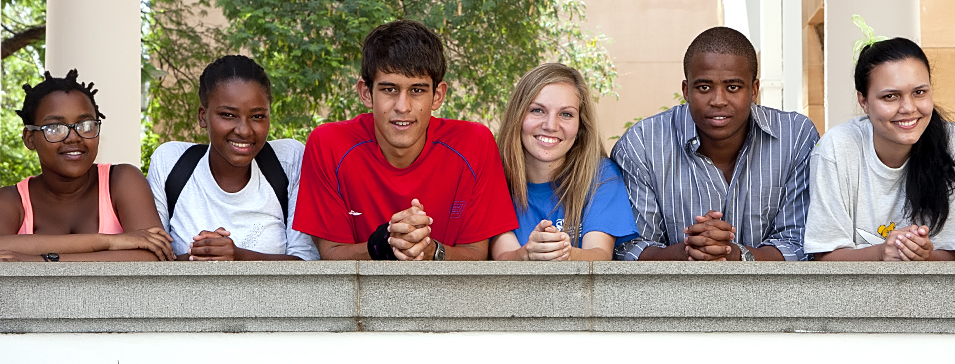 |
From left are: Saneliswe Khambule, Lungile Mkhungo, Jannie de Wet, Anje Venter, Siqiniseko Buthelezi and Abrille Beukes.
Photo: Hannes Pieterse |
Hailing from top schools in KwaZulu-Natal (KZN), Naushad Mayat, Lungile Mkhungo and Siqiniseko Buthelezi share 20 distinctions between them. Leaving the province of the Zulu Kingdom for Bloemfontein, all three are at Kovsies to study as doctors.
Naushad obtained eight distinctions, an achievement that placed him in the top ten matriculants in KwaZulu-Natal. The former learner from Glenwood High School in Durban came fourth in the Umlazi District and tenth overall in the province. Enrolling for a degree in Medicine, he will join the list of outstanding health professionals Kovsies produce every year.
Lungile, who matriculated from Kingsway High School, attained seven distinctions and her average percentage was 90%. She received distinctions in English – 90%, IsiZulu – 94%, Mathematics – 83%, History – 92%, Physics – 89%, Life Sciences – 89% and Life Orientation – 93%. Lungile is not only clever, but also performed well in sports at her school, participating in netball, soccer and athletics. This future doctor is a proud resident of Wag-'n-Bietjie residence.
Siqiniseko made history at his school, Maritzburg College, becoming the first black Head Prefect at the 150-year-old school, the oldest boys' high school in KZN and one of the oldest schools in South Africa. A gifted learner excelling in sport, culture and academics, Siqiniseko obtained five distinctions (English, Afrikaans, Life Orientation, Accounting and Life Sciences). His sporting prowess has seen him captaining Maritzburg College's first rugby team, as well as the KZN Academy team.
The three are joined by fellow KwaZulu-Natal resident, Saneliswe Khambule, Namibian Abrille Beukes and Free Staters Anje Venter and Jannie de Wet.
Saneliswe, a former learner of Menzi High School in Umlazi, received five distinctions in her final-year exams. The Emily Hobhouse resident registered for a Forensic Science degree and plans on doing her doctoral studies in this exciting career field.
Abrille Beukes is another future doctor and is all the way from Windhoek in Namibia. Abrille obtained a ‘one’ in all her subjects, the highest possible mark in the Namibian school system. The Windhoek-born student received high levels in Mathematics, Accounting, Physical Science, Biology, Afrikaans and English. As second best student in her home country, she will register for a Medicine degree.
Anja, the Free State’s top achiever, received an average percentage of 93% in the matric final exams. The former Eunice student obtained nine distinctions, an achievement that placed her in the national top 100 matriculants. Anja enrolled for a BSc Actuarial Science degree and will be joined in class by former school friend, Jannie de Wet, who obtained a whopping ten distinctions. Jannie and Anja attended Universitas Primary School together, with Jannie finishing his school career at Jim Fouché High School, and just like Anja, he will also enrol for a BSc Actuarial Science degree.
Jannie obtained distinctions in Afrikaans, English, Mathematics, Mathematics (third paper), Life Orientation, Accounting, Physical Science, Life Science, Economics and Information Technology. Jannie is also the Volksblad and the University of the Free State’s 2013 Matriculant of the Year.